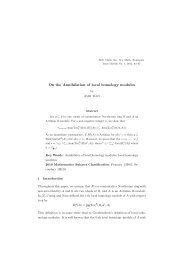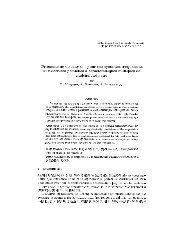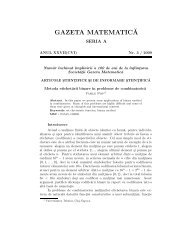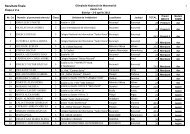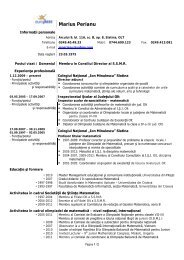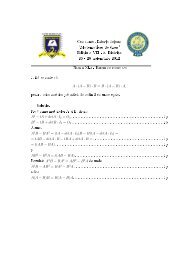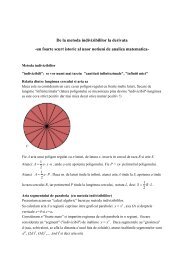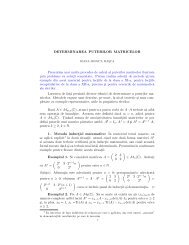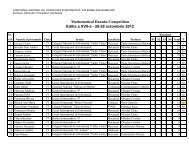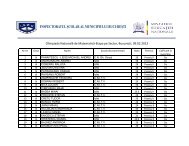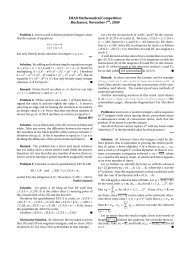A survey on strong KT structures - SSMR
A survey on strong KT structures - SSMR
A survey on strong KT structures - SSMR
You also want an ePaper? Increase the reach of your titles
YUMPU automatically turns print PDFs into web optimized ePapers that Google loves.
A <str<<strong>strong</strong>>on</<strong>strong</strong>>g>survey</str<<strong>strong</strong>>on</<strong>strong</strong>>g> <<strong>strong</strong>>on</<strong>strong</strong>> str<<strong>strong</strong>>on</<strong>strong</strong>>g <strong>KT</strong> <strong>structures</strong> 1053 Str<<strong>strong</strong>>on</<strong>strong</strong>>g <strong>KT</strong> metrics, currents, blow-ups and resoluti<<strong>strong</strong>>on</<strong>strong</strong>>sOn a compact complex manifold the Kähler, balanced and str<<strong>strong</strong>>on</<strong>strong</strong>>g <strong>KT</strong> c<<strong>strong</strong>>on</<strong>strong</strong>>diti<<strong>strong</strong>>on</<strong>strong</strong>>can be characterized by using c<<strong>strong</strong>>on</<strong>strong</strong>>diti<<strong>strong</strong>>on</<strong>strong</strong>>s <<strong>strong</strong>>on</<strong>strong</strong>> the space of positive currents.We start to review some known facts about positive currents. Let Ω be an openset of C n and let Λ p,q (Ω) (respectively by D p,q (Ω)) be the space of (p,q)-forms(respectively (p,q)-forms with compact support) <<strong>strong</strong>>on</<strong>strong</strong>> Ω. On the space D p,q (Ω) <<strong>strong</strong>>on</<strong>strong</strong>>ec<<strong>strong</strong>>on</<strong>strong</strong>>siders the C ∞ -topology and <<strong>strong</strong>>on</<strong>strong</strong>>e defines the space of currents of bi-dimensi<<strong>strong</strong>>on</<strong>strong</strong>>(p,q) or of bi-degree (n − p,n − q) as the topological dual D p,q(Ω) ′ of D p,q (Ω). Acurrent of bi-dimensi<<strong>strong</strong>>on</<strong>strong</strong>> (p,q) <<strong>strong</strong>>on</<strong>strong</strong>> Ω can be viewed as a (n − p,n − q)-form <<strong>strong</strong>>on</<strong>strong</strong>> Ωwith coefficients distributi<<strong>strong</strong>>on</<strong>strong</strong>>s.A current T ∈ D p,q(Ω) ′ is said to be of order 0 if its coefficients are measuresand is called normal if T and dT are currents of order 0.A current T of bi-dimensi<<strong>strong</strong>>on</<strong>strong</strong>> (p,p) is real if T(ϕ) = T(ϕ), for any ϕ ∈ D p,q (Ω).Therefore, if T ∈ D p,p(Ω) ′ is real, then T can be expressed as∑T = σ n−p T IJdz I ∧ dz J ,I,Jwhere σ n−p = i(n−p)22 (n−p) , T IJare distributi<<strong>strong</strong>>on</<strong>strong</strong>>s <<strong>strong</strong>>on</<strong>strong</strong>> Ω such that T JI= T IJand I, Jare multi-indices of length n − p, I = (i 1 ,...,i n−p ), dz I = dz i1 ∧ · · · ∧ dz in−p .A real current T ∈ D ′ p,p(Ω) is positive ifT(σ p ϕ 1 ∧ · · · ∧ ϕ p ∧ ϕ 1 ∧ · · · ∧ ϕ p ) ≥ 0for any choice of ϕ 1 ,...,ϕ p ∈ D 1,0 (Ω), where σ p = ip22 p . Moreover, T is strictlypositive if ϕ 1 ∧ · · · ∧ ϕ p ≠ 0 implies T(σ p ϕ 1 ∧ · · · ∧ ϕ p ∧ ϕ 1 ∧ · · · ∧ ϕ p ) > 0.If T is a positive current of bi-degree (p,p), then T is of order 0.A real current T of bi-dimensi<<strong>strong</strong>>on</<strong>strong</strong>> (p,p) <<strong>strong</strong>>on</<strong>strong</strong>> Ω is said to be negative if the current−T is positive and plurisubharm<<strong>strong</strong>>on</<strong>strong</strong>>ic if i∂∂T is positive.Given a Hermitian structure (J,g) <<strong>strong</strong>>on</<strong>strong</strong>> a complex manifold M, then the fundamental2-form F corresp<<strong>strong</strong>>on</<strong>strong</strong>>ds to a real strictly positive current of bi-degree(1,1). In particular, if the Hermitian structure (J,g) is str<<strong>strong</strong>>on</<strong>strong</strong>>g <strong>KT</strong>, then thecorresp<<strong>strong</strong>>on</<strong>strong</strong>>ding current is ∂∂-closed.An important type of ∂∂-closed currents is given by the (p,p)-comp<<strong>strong</strong>>on</<strong>strong</strong>>ents ofa boundary. We recall that a current T of bi-degree (p,p) is said to be the (p,p)-comp<<strong>strong</strong>>on</<strong>strong</strong>>ent of a boundary if there exists a real current S of bi-degree (p,p − 1)such that T = ∂S + ∂S.Harvey and Laws<<strong>strong</strong>>on</<strong>strong</strong>> proved that a compact complex manifold admits a Kählermetric if and <<strong>strong</strong>>on</<strong>strong</strong>>ly if there is no n<<strong>strong</strong>>on</<strong>strong</strong>>-zero positive current of bi-dimensi<<strong>strong</strong>>on</<strong>strong</strong>> (1,1)which is the (1,1)-comp<<strong>strong</strong>>on</<strong>strong</strong>>ent of a boundary (see [26]). A first generalizati<<strong>strong</strong>>on</<strong>strong</strong>> ofthe previous result was obtained by Michels<<strong>strong</strong>>on</<strong>strong</strong>> in [40] and it is the following: acompact complex manifold has a balanced metric if and <<strong>strong</strong>>on</<strong>strong</strong>>ly if there is no n<<strong>strong</strong>>on</<strong>strong</strong>>zeropositive current of bi-dimensi<<strong>strong</strong>>on</<strong>strong</strong>> (n − 1,n − 1), which is the (n − 1,n − 1)-comp<<strong>strong</strong>>on</<strong>strong</strong>>ent of a boundary. In the case of str<<strong>strong</strong>>on</<strong>strong</strong>>g <strong>KT</strong> metrics, Egidi proved in [14]




